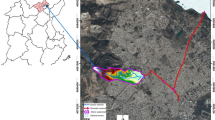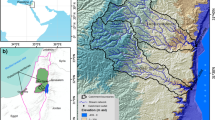Abstract
The Koraiyar River basin is located in Tiruchirappalli city, one of the fastest-growing medium-sized cities in south India. Over the decades, the city has experienced sporadic flooding in vast areas due to the breaching of bunds when the river is in spate. The objective of this investigative study is to simulate rainfall–runoff in the Koraiyar basin watershed through the reliable Hydrologic Modelling System developed by the Hydrologic Engineering Center (HEC-HMS). Land-use and land-cover constantly change due to increasing population taken as one of parameter, its influence on CN, and their impact on surface runoff is analyzed in this study. The specified hyetograph method is adopted for the meteorological modelling; the Soil Conservation Services-Curve Number (SCS-CN) is selected to calculate the loss rate, and the SCS unit hydrograph method is adopted to simulate the runoff rate. Calibration and validation of the model are done to simulate assessed peak discharge values for comparison with actual observed values. The Nash–Sutcliffe efficiency coefficient is between 0.5 and 0.6, which indicates that the hydrological modelling results are satisfactory and acceptable for simulation of rainfall–runoff. The peak discharge is obtained for the single maximum rainfall event of about 100 mm in a day over the past 40 years, and hydrographs are generated.
Highlights
-
It is the first integrated rainfall–runoff modelling to be studied in Ungauged Koraiyar basin with scarce data.
-
The methodology adopted for simulating selected extreme events can be used for similar hydrological and meteorological conditions.
-
For ungauged catchments like Koraiyar basin characteristics where enough data is not available, HEC-HMS can be used as a reliable tool for rainfall runoff and flood flow simulation.














Similar content being viewed by others
References
Ali M, Khan S J, Aslam I and Khan Z 2011 Simulation of the impacts of land-use change on surface runoff of Lai Nullah Basin in Islamabad, Pakistan; Landscape Urban Plan. 102 271–279.
Anandharuban P, Rocca M L and Elango L 2019 A box-model approach for reservoir operation during extreme rainfall events: A case study; J. Earth Syst. Sci. 128(229) 1–14, https://doi.org/10.1007/s12040-019-1258-7.
Apel H, Aronica G T, Kreibich H and Thieken A H 2009 Flood risk analyses – how detailed do we need to be?; Nat. Hazards 49 79–98.
Aryal et al. 2020 A model-based flood hazard mapping on the southern slope of Himalaya; Water 12 540, https://doi.org/10.3390/w12020540.
Azama M, Kimb H S and Maenga S J 2017 Development of food alert application in Mushim stream watershed Korea; Int. J. Disaster Risk Reduct. 21 11–26.
Bates P D 2004 Remote sensing and flood inundation modeling; Hydrol. Process. 18 2593–2597.
Bhaskar N R 1988 Projection of urbanization effects on runoff using Clark’s instantaneous unit hydrograph parameters; Water Resour. Bull. 24(1) 113–124.
Cheng S J and Wang R Y 2002 An approach for evaluating the hydrological effects of urbanization and its application; Hydrol. Process. 16 1403–1418.
Chu H J and Chang L C 2009 Applying particle swarm optimization to parameter estimation of the nonlinear muskingum model; J. Hydrol. Eng. 14 1024–1027.
Dhruvesh P P and Prashant K S 2013 Flood hazards mitigation analysis using remote sensing and GIS: Correspondence with Town Planning Scheme; Water Resour. Manag. 27 2353–2368.
Eyad A and Broder M 2013 Modelling rainfall runoff relations using HEC-HMS and IHACRES for a single rain event in an arid region of Jordan; Water Resour. Manag. 27 2391–2409, https://doi.org/10.1007/s11269-013-0293-4.
Ferguson B K and Suckling P W 1990 Changing rainfall–runoff relationships in the urbanizing Peachtree Creek watershed, Atlanta, Georgia; Water Resour. Bull. 26(2) 313–322.
Hapuarachchi H A P, Wang Q J and Pagano T C 2011 A review of advances in flash flood forecasting; Hydrol. Process. 25 2771–2784, http://dx.doi.org/10.1002/hyp.8040.
Huang H J, Cheng S J, Wen J C and Lee J H 2008 Effect of growing watershed imperviousness on hydrograph parameters and peak discharge; Hydrol. Process. 22(13) 2075–2085.
Im S, Brannan K M and Mostaghimi S 2003 Simulating hydrologic and water quality impacts in an urbanizing watershed; J. Am. Water Resour. Assoc. 39 1465–1479.
Ismail E 2015 Flash flood hazard mapping using satellite images and GIS tools: A case study of Najran City, Kingdom of Saudi Arabia (KSA); Egyptian J. Remote Sens. Space Sci. 18 261–278.
Jakeman A J and Hornberger G M 1993 How much complexity is warranted in a rainfall–runoff model?; Water Resour. Res. 29(8) 2637–2649.
Khatri H B, Jain M K and Jain S K 2018 Modelling of streamflow in snow dominated Budhigandaki catchment in Nepal; J. Earth Syst. Sci. 127 100, https://doi.org/10.1007/s12040-018-1005-5.
Kim E S and Choi H 2015 A method of flood severity assessment for predicting local flood hazards in small ungauged catchments; Nat. Hazards 78 2017–2033.
Knebla M R et al. 2005 Regional scale food modelling using NEXRAD rainfall, GIS, and HEC-HMS/RAS: A case study for the San Antonio River Basin Summer 2002 storm event; J. Environ. Manag. 75 325–336.
Komuscu A U and Celik S 2012 Analysis of the Marmara flood in Turkey, 7–10 September 2009: An assessment from hydrometeorological perspective; Nat. Hazards, https://doi.org/10.1007/s11069-012-0521-x.
Laouacheria F and Mansori R 2015 Comparison of WBNM and HEC-HMS for runoff hydrograph prediction in a small urban catchment; Water Resour. Manag. 29 2485–2501, https://doi.org/10.1007/s11269-015-0953-7.
Lastra J et al. 2008 Flood hazard delineation combining geomorphological and hydrological methods: An example in the Northern Iberian peninsula; Nat. Hazards 45 277–293.
Lillesand T M and Kiefer R W 2003 Remote sensing and image interpretation; New York: John Wiley and Sons.
Liu Y and Sun F 2010 Sensitivity analysis and automatic calibration of a rainfall–runoff model using multi-objectives; Ecol. Inf. 5 304-310.
Madsen H 2000 Automatic Calibration of a conceptual rainfall–runoff model using multiple objectives; J. Hydrol. 235(3) 276–288, https://doi.org/10.1016/S0022-1694(00)00279-1.
Maity R 2018 Frequency analysis, risk, and uncertainty in hydroclimatic analysis; Stat. Methods Hydrol. Hydroclimatol. 444p, https://doi.org/10.1007/978-981-10-8779-0.
Matej V and Jana V 2016 Flood hazard and flood risk assessment at the local spatial scale: A case study; Geomatics, Nat. Hazards and Risk 7(6) 1973–1992.
Mehdi K, Alireza S and Bahram S 2018 Loss of life estimation due to flash floods in residential areas using a regional model; Water Resour. Manag. 32 4575–4589.
Merwade V 2010 Creating SCS Curve Number Grid using HEC Geo HMS; School of Civil Engineering, Purdue University, http://web.ics.purdue.edu/∼vmerwade/education/cngrid.pdf.
Moriasi D N, Arnold J G, Van Liew M W, Bingner R L, Harmel R D and Veith T L 2007 Model evaluation guidelines for systematic quantification of accuracy in watershed simulation; Trans. ASABE 50(3) 885–900.
Nash J E and Sutcliffe J E 1970 River flow forecasting through conceptual models. Part 1: A discussion of principles; J. Hydrol. 10 282–290.
Onusluel G, Nilgun H and Ali G 2010 A combined hydrologic and hydraulic modelling approach for testing efficiency of structural flood control measures; Nat. Hazards 54 245–260.
Pawan N B and Jayantilal N P 2018 Event-based rainfall–run-off modelling and uncertainty analysis for lower Tapi Basin, India; ISH J. Hydraul. Eng., https://doi.org/10.1080/09715010.2018.1464406.
Ramakrishnan D, Bandyopadhyay A and Kusuma K N 2009 SCS-CN and GIS-based approach for identifying potential water harvesting sites in the Kali Watershed, Mahi River Basin, India; J. Earth Syst. Sci. 118(4) 355–368.
Reddy A M 2002 Text book of remote sensing and geographical information systems; Saint John: B.S. Publications.
Sampath D, Weerakoon S and Herath S 2015 HEC-HMS model for runoff simulation in a tropical catchment with intra-basin diversions case study of the Deduru Oya River Basin, Sri Lanka; Engineer. 48(01) 1–9, https://doi.org/10.4038/engineer.v48i1.6843.
Scharffenberg W and Fleming M 2010 Hydrologic modelling system HEC-HMS v32 user’s manual; USACEHEC, Davis.
Sintayehu L G 2015 Application of the HEC-HMS model for runoff simulation of Upper Blue Nile River Basin; Hydrol. Curr. Res. 6(2) 199, https://doi.org/10.4172/2157-7587.1000199.
Surendar N and Nisha R 2019 Simulation of extreme event–based rainfall–runoff process of an urban catchment area using HEC–HMS; Model. Earth Syst. Environ. 5 1867–1881, https://doi.org/10.1007/s40808-019-00644-5.
Suribabu C R, Bhaskar J and Neelakantan T R 2012 Land use/cover change detection of Tiruchirapalli city, India using integrated remote sensing and GIS tools; J. Indian Soc. Rem. Sens. 40(4) 699–708.
Suribabu C R and Bhaskar J 2015 Evaluation of urban growth effects on surface runoff using SCS–CN method and Green-Ampt infiltration model; Earth Sci. Inform. 8 609–626, https://doi.org/10.1007/s12145-014-0193-z.
Tung Y K and Mays L W 1981 State variable model for urban rainfall–runoff process; Water Resour. Bull. 17(2) 181–189.
United States Army Corps of Engineers (USACE) 2008 Hydrological modelling system, HEC-HMS, user’s manual, version 3.3; Davis, CA, USA.
US Army Corps of Engineers (USACE) 2013 Hydrologic Engineering Centre: Hydrologic modelling system HEC-HMS, user’s manual version 4; http://www.hec.usace.army.mil/software/hec-geohms/downloads.aspx.
USDA 1972 National engineering handbook, section 4, hydrology, soil conservation service; US Government Printing Office, Washington, DC.
USGS 2012 Estimating basin lag time and hydrograph timing indexes used to characterize storm flows for runoff-quality analysis; Scientific Investigations Report, Reston, Virginia, USA, U.S. Geological Survey, 58p.
Xuefeng C and Steinman A 2009 Event and continuous hydrologic modelling with HEC–HMS; J. Irrig. Drain. Eng. 135 1(119) 119–124, https://doi.org/10.1061/(asce)0733-9437 (2009).
Yang X L, Ren L L, Singh V P, Liu X F, Yuan F, Jiang S H and Yong B 2012 Impacts of land use and land cover changes on evapotranspiration and runoff at Shalamulun River watershed, China; Hydrol. Res. 43(1–2) 23–37.
Yuan W, Liu M and Wan F 2019 Calculation of critical rainfall for small-watershed flash floods based on the HEC-HMS hydrological model; Water Resour. Manag. 33 2555–2575, https://doi.org/10.1007/s11269-019-02257-0.
Yucel I 2015 Assessment of a flash flood event using different precipitation datasets; Nat. Hazards 79 1889–1911.
Yusop Z, Chan C H and Katimon A 2007 Runoff characteristics and application of HEC–HMS for modelling storm flow hydrograph in an oil palm catchment; Water Sci. Technol. 56 41–48.
Zafar S and Zaidi A 2015 Impact of urbanization on basin hydrology: A case study of the Malir Basin, Karachi, Pakistan; Regional Environmental Change, https://doi.org/10.1007/s10113-019-01512-9.
Zaharia L, Costache R, Pravălie R and Minea G 2015 Assessment and mapping of flood potential in the Slănic catchment in Romania; J. Earth Syst. Sci. 124(6) 1311–1324.
Zhang H L, Wang Y J, Wang Y Q, Li Q D and Wang X K 2013 The effect of watershed scale on HEC-HMS calibrated parameters: A case study in the clear creek watershed in Iowa, US; Hydrol. Earth Syst. Sci. 17 2735–2745.
Zope P E, Eldho T I and Jothiprakash V 2015 Impacts of urbanization on flooding of a coastal urban catchment: A case study of Mumbai City, India; Nat. Hazards 75 887–908.
Acknowledgements
The authors gratefully acknowledge the State Surface and Groundwater Data Centre, Chennai, and Irrigation Management Training Institute for providing rainfall data, Tiruchirappalli. The authors also extend their thanks to USGS, SRTM website for providing Remote Sensing Images freely available. The US Army Corps of Engineers were appreciated for providing HEC-HMS and HEC-RAS is open-source software. Finally, to the Editor of this journal, the reviewers for making much effort to review the manuscripts and their team for their great support during the review of the submitted manuscript.
Author information
Authors and Affiliations
Contributions
The first author Surendar Natarajan contributed in this study by data collection, framed methodology of the study, analysis, results and preparation of manuscript. The results and manuscript were reviewed and corrected by second author Nisha Radhakrishnan.
Corresponding author
Additional information
Communicated by Rajib Maity
Rights and permissions
About this article
Cite this article
Natarajan, S., Radhakrishnan, N. Simulation of rainfall–runoff process for an ungauged catchment using an event-based hydrologic model: A case study of koraiyar basin in Tiruchirappalli city, India. J Earth Syst Sci 130, 30 (2021). https://doi.org/10.1007/s12040-020-01532-8
Received:
Revised:
Accepted:
Published:
DOI: https://doi.org/10.1007/s12040-020-01532-8




